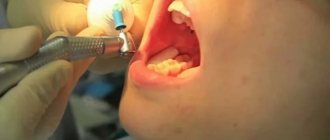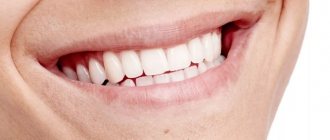February 28, 2020
Many people think that pus at the root of a tooth is an extensive process that occurs with acute pain and is difficult to miss. However, in reality everything may be completely different. For example, a granuloma can remain undetected for a long time and be asymptomatic; it is small in size, but contains pus. And, of course, dangerous to health. The editors of the UltraSmile.ru portal decided to talk about the pathology in more detail. The article will discuss how granuloma can be recognized and treated in time, and what complications may arise if this is not done in time.
What is granuloma
Granuloma is a small nodular inflammation of soft tissue. Its size usually does not exceed 5–7 mm in diameter, but if left untreated for a long time, it begins to increase and can lead to destruction of bone tissue. Pus accumulates inside it. The granuloma is localized at the root of the tooth, more often at its apex. It is the most common apical lesion1 (that is, located at the apex of the tooth root).
The photo shows the process of pathology formation
Did you know that a dental microscope is a powerful aid in the treatment of cysts and granulomas? With the help of multiple magnification achieved by the device, the doctor treats not by touch, but with certainty. And what is very important is that the presence of the device and an experienced endodontist in the clinic where you go means a high chance that a tooth with a similar problem will be saved, after which it will serve for many more years.
What does a dental granuloma look like?
The photos and x-rays that we post below will help you see what a dental granuloma looks like.
Signs of the disease
People who have this pathology do not notice it for a long time because they have no painful sensations. If acute pain appears, this indicates that the disease is advanced or has worsened. But then it is accompanied by other symptoms: swelling and redness of the gums in the area where the pathology is located, the release of pus from the periodontal pocket, a general deterioration in well-being, and darkening of the tooth.
How to detect pathology at an early stage of development if it does not manifest itself with any symptoms for a long time? A dental granuloma is clearly visible on an x-ray. Accordingly, it can only be detected at a dentist’s appointment. If you undergo preventive examinations twice a year and take a panoramic photo of the jaw, the problem will be detected in time. It is also important to treat teeth promptly and competently - caries, pulpitis, periodontitis precede the development of a tumor.
Dental granuloma is clearly visible on x-ray
Symptoms
The disease manifests itself as a dull pain when eating solid food. A fistula may form on the gum. Patients also complain of:
- swelling of the face;
- swelling;
- increased body temperature;
- weakness, decreased performance;
- high sensitivity to temperature changes;
- increased volume and tenderness of the lymph nodes;
- toothache.
If a tooth looks healthy, but pain occurs when pressing on it, you should definitely make an appointment with a dentist. The same must be done if the gum is swollen, swollen, or a fistula has formed on its surface.
Why does granuloma need to be treated?
Many patients think that granuloma does not pose a serious danger, because the formation is very small and does not cause much discomfort. There are also people who are sure that pus on the root of a tooth with such a pathology can resolve on its own. But all these judgments are wrong.
In fact, if left untreated, granuloma can lead to complete destruction of the tooth root and the need for its removal, but this is only the mildest of complications.
Granuloma on the root of a tooth most often develops if a person has not undergone treatment or it was of poor quality. For example, when caries is complicated by pulpitis, and pulpitis by periodontitis. The risk of a tumor increases significantly if the patient has concomitant factors: hypothermia, injury, decreased immunity, hormonal changes or other diseases of the body.
A small purulent sac begins to enlarge and can gradually degenerate into a cyst, which in advanced cases reaches 5–6 cm in diameter. Pus can seek a way out, and then a fistula tract is formed. It can open not only into the oral cavity, but also inside the body, which can lead to infection of internal organs and the development of sepsis.
The following purulent complications are also possible: perimandibular abscess, or phlegmon, osteomyelitis. If bacteria penetrate other organs (and with a granuloma this is not difficult, because it consists of tissue with a large number of capillaries and blood vessels), then sinusitis, meningitis, arthritis of the jaw joint, and otitis may develop.
Tooth root granuloma in an advanced stage often causes complications on the cardiovascular system and kidneys, becoming a provoking factor for the development of pyelonephritis and myocarditis.
What causes dental granuloma: the main reasons
There are two main reasons for the formation of granulomas:
1. Untreated pulpitis or inflammation of the nerve of the tooth. With pulpitis, the infection penetrates the nerve of the tooth and if it is not treated, the nerve will die and the pain will stop for a while, but the inflammatory process will not. The infection will continue to spread and travel through the root canals to the root of the tooth. When inflammation begins at the apex of the tooth root, periodontitis occurs, one of the forms of which is dental granuloma.
YOU NEED TO REMEMBER: Very often on dental forums the question is asked: can a granuloma occur under a filling or crown, because the tooth seems to have been cured and the inflammatory process in it has been stopped? This question can be answered this way: if the tooth treatment was performed poorly, then a dental granuloma may well develop both under the filling and under the crown. If the dentist, when working with a tooth, does not remove all tissues affected by caries, the inflammatory process will continue to develop and sooner or later will move to the root part of the tooth.
2. The second reason for the formation of granulomas is the poor quality of root canal filling. This procedure is necessarily carried out when depulping a tooth and, if mistakes are made in it, a granuloma can also appear on a tooth with a removed nerve. The tooth canals must not only be thoroughly cleaned, but also be properly filled with filling material.
The cause of the occurrence and development of dental granuloma can be non-compliance with medical recommendations after complex dental treatment. For example, if during treatment the gums were injured and the dentist prescribed the patient a course of anti-inflammatory therapy and rinsing, and the person decided to ignore these instructions, the infection could get into the open wound and trigger the development of a granuloma.
Very rarely, granulomas occur after tooth trauma or after poorly performed orthodontic dental treatment.
YOU NEED TO REMEMBER: Often people choose dentistry for dental treatment based solely on the prices of services. This is wrong; you need to choose a clinic for the treatment of dental granuloma and other dental diseases according to other criteria - the level of equipment, the competence of the specialists working in it. Our dentistry in Moscow - VENSTOM - has created all the conditions for high-quality, painless and comfortable dental treatment!
Conservative and drug treatment
Timely detection of a granuloma on an x-ray allows the dentist to apply the most loyal approach to the treatment of this pathology. Here are the actions that will be taken then:
- cleaning and antiseptic treatment of tooth root canals,
- placing a drug based on calcium hydroxide inside the channels,
- applying a temporary filling,
- installation of a permanent filling.
The second and third points can be repeated repeatedly until the formation finally resolves. Additionally, the doctor prescribes home therapy for the patient, which consists of taking antibiotics and painkillers, and performing antiseptic mouth rinses, for example, with Chlorhexidine.
The photo shows the process of conservative treatment
Many doctors believe that this measure is not always effective; often, after conservative therapy, the disease can recur. But patients do not always like that treatment can last for 4–6 months. However, if you don't want to resort to more radical solutions, then it's worth a try.
“A year ago, I began to notice that when I chew on one tooth, it hurts, but after eating, the pain goes away immediately. I didn’t think that I needed to go to the dentist with such a problem: the tooth was treated and filled. But one fine day he began to get so sick, even regardless of food intake, that he ran to the doctor. A diagnosis of granulomatous periodontitis was made. They treated him for a very long time, put medicine inside him for almost a year, but the tumor at the root did not resolve, and it had to be removed surgically. I don’t know, maybe I should have deleted it right away instead of suffering like that...”
Helga32, review from the dental portal gidpozubam.ru
Physiotherapeutic methods
In some clinical cases, when the granuloma is small and the inflammatory process is not acute, treatment is possible using the following methods.
Electrophoresis
This procedure involves introducing iodine-based medications into the infected canals using current pulses, designed to kill bacteria and also promote the resorption of the formation. True, physiotherapy requires patience and a lot of free time, because it will take about 10–20 procedures performed daily or every other day to get rid of the pathology.
Depophoresis
Another physiotherapeutic method is depophoresis. The principle of introducing medication into the root canals here is similar to that of electrophoresis. Copper/calcium hydroxide is used only as the main drug. Depophoresis can only be performed on teeth that lack pulp. The number of procedures is usually three, with a break of a week between them.
This method does not require complex surgical procedures.
Destruction of granuloma with laser
The method is more expensive, but fast and effective. Suitable even for curved root canals. Before this, the specialist cleans the canals and sterilizes them. Penetrating through the root, the doctor treats the granuloma with a laser, and it resolves. The laser has a powerful disinfecting effect, does not injure surrounding tissues, on the contrary, promotes their rapid healing, stops bleeding, because cauterizes blood vessels. Doctors who practice this type of innovative equipment claim that relapses of the disease are excluded.
The laser has a powerful disinfecting effect
Contraindications to the use of laser: oncology, cracks and fractures at the root.
Surgical methods
If a patient has a granuloma on the root of a tooth, and conservative treatment and physiotherapy have not yielded results, there is only one way out - surgery. This also applies to severely advanced cases.
If the pus on the root of the tooth has led to an acute inflammatory process, then it is first removed using drainage and only after that the removal of the granuloma begins. Most often, the granulomatous nodule is curetted using cystectomy; the procedure is combined with resection of the apex of the tooth root, i.e. part of the root is excised along with the neoplasm. Such measures allow you to save the tooth itself.
The photo shows the procedure for removing pus
Another less gentle type of surgical intervention, which nevertheless allows you to save the tooth, is hemisection. This operation can only be performed on multi-root elements. Indicated when it is not possible to save one of the roots, then the root is removed along with part of the crown adjacent to it. After the procedure, the patient is required to undergo prosthetics with an artificial crown as soon as possible to restore shape, aesthetics and functionality.
There is another surgical method that is least desirable for any patient - removal of the granuloma along with the affected tooth. This is an extreme measure, but with extensive destruction of hard tissue and severe inflammation, it is not always possible to avoid it.
Surgical treatment is always accompanied by taking antibacterial and painkillers, and rinsing the mouth with antiseptic solutions.
How can a fistula on the gum be cured?
Of course, we treat it, we deal with it, we work for it. In order to cure a fistula on the gum, first of all, we should eliminate the reason due to which the fistula occurred. We should not
fight the pimple itself, smear it with various ointments and lotions, but must eliminate the cause of its occurrence.
We must
eliminate the chronic inflammation itself that led to this fistula.
The first treatment option for a fistula is endodontic
For such treatment, we provide the patient with high-quality endodontic treatment under a microscope when:
- the tooth canal itself is visible,
- its branches are visible
- and you can see if there are cracks in the tooth canal.
Our doctors perform minimally invasive treatment procedures under a microscope at a high level. Treatment of processes that led to a fistula, to a fistulous tract on the gum, to complications of various periodontitis. In the video - endodontist of the Scientific Research Center, winner of many international competitions in endodontics and dental restoration Melikov Azer:
In the clinics of the German Implantology Center, special materials are used that seal the apical part very well and for a long period, which are biocompatible with the tissues surrounding the tooth and which give a very good result.
That is, we have a therapeutic method of treatment - this time
. When highly qualified endodontists, using microscopes, special equipment and special materials, carry out canal therapy and eliminate the cause of the fistula.
The second treatment option for fistula is mixed
Second method
- This is a mixed treatment, when treatment is carried out jointly by a therapist and a surgeon. If the lesion is already quite strong, lysis of a certain part of the root apex has occurred, when the process has already been going on for quite a long time, then the therapist cleans the canals:
seals the apical part of the root with a special material, and the surgeon opens, makes surgical access and polishes the apical part of the tooth root.
We do not perform dental resections when the tooth is cut down in half. You often think, I often have patients come to me who have had a resection and you think the person has had ⅔ of the root cut off and this tooth is no longer tenable, it can barely hold on, and why did it have to be done? We do it minimally invasively. We polish the apical part of the root with special ultrasonic tips after the therapist has carried out the treatment, and we get very good long-term results.
The third treatment option is surgery.
There is also a surgical method - this is the third method
treatment when the inflammation is already chronic according to the principle “No tooth - no caries, no periodontitis, no nothing.”
That is, the tooth is removed
, the source of inflammation is removed:
and an implant is placed
:
Subsequent rehabilitation of the patient takes place on the implant.
The fourth treatment option is autotransplantation.
Autotransplantation is a type of third, surgical treatment option. But the patient’s own donor tooth acts as an implant. As a rule, wisdom teeth, which are not involved in the process of chewing food and are actually the body’s reserve for such cases, are excellent for this role. Wisdom teeth transplantation is suitable for posterior teeth and premolars (fourth, fifth, sixth and seventh teeth).
Advantage
This method of treatment is that the patient’s own tooth is transplanted, the patient’s own tissue, which is not foreign to the body, even in conditions of the inflammatory process with a fistula, significantly reduces the risk of tooth-implant rejection.
The specialists of the German Implantology Center have accumulated many years of clinical experience in such operations. You can see how the autotransplantation operation takes place in the following video. There, at the end of the film, the patient shares his impressions of the dental transplant (this is a review 1 year after
the transplant operation):
Is it possible to cure granuloma using traditional methods?
Treatment of pathology with folk remedies is ineffective. Decoctions of various herbs can only bring temporary relief when there are signs such as inflammation and swelling of the tissues surrounding the tooth, and pain. It must be remembered that rinsing with herbs or soda acts locally, and the granuloma is located at the root of the tooth, and beneficial substances from decoctions or solutions do not penetrate to it.
It is unacceptable to warm up a diseased tooth, on the root of which pus has accumulated, because then this is fraught with the spread of infection deep into the body, the breakthrough of purulent contents into the circulatory and lymphatic systems, into the surrounding tissues.
Notice
: Undefined variable: post_id in
/home/c/ch75405/public_html/wp-content/themes/UltraSmile/single-item.php
on line
45 Notice
: Undefined variable: full in
/home/c/ch75405/public_html/wp-content /themes/UltraSmile/single-item.php
on line
46
Rate this article:
( 2 ratings, average: 5.00 out of 5)
flux
- Mammadzade R.E. Non-surgical treatment of teeth with large periapical destruction // Modern dentistry. – 2017.
Expert “Granuloma can remain dormant for a long time. But a viral infection, hypothermia and even a severe stressful situation can cause tumor growth. The best measure to prevent disease is timely examinations and treatment of oral diseases.” Dentist-therapist Elina Ruslanovna Dzagurova
Consulting specialist
Dzhutova Aida Vladimirovna
Doctor rating: 8.8 out of 10 (5) Specialization: Implant surgeon, periodontist Experience: 10 years
Comments
Once a year I definitely go for an examination with a dentist, and this time he discovered a granuloma... and recommended removing the tooth right along with it!!! How is it possible, why deletion if it was discovered in a short time????
Yulia V. (03/12/2020 at 06:22 pm) Reply to comment
- Yulia, it can be assumed that conservative treatment, as well as surgery with preservation of the tooth, is impossible due to the presence of a root crack, or the inflammation has progressed greatly this year under the influence of other factors (general diseases of the body, stress, hypothermia). Another reason is severe destruction of tooth tissue, in which its preservation is not possible. Try contacting another doctor to compare the results of the study and the proposed methods for solving the problem.
Editorial staff of the portal UltraSmile.ru (03/20/2020 at 09:09) Reply to comment
If the dentist advises surgical removal of the granuloma, how long does the healing process take and what complications may occur? I’m worried that I’ll have to take time off from work; after all, this is an operation, albeit of a local nature.
Tatyana (03/20/2020 at 07:53) Reply to comment
Recently at an appointment I was diagnosed with a granuloma. But the dentist suggested only one way - tooth extraction. He said that during treatment there are no guarantees that in a year the tooth may have to be removed anyway. How justified is this? Maybe you should contact another specialist?
Lydia (03/20/2020 at 08:37) Reply to comment
Is it really necessary to take a panoramic photo twice a year? I think that a competent dentist, during an annual examination if there are complaints, should recommend this procedure. And then do it.
Peter (03/20/2020 at 10:00) Reply to comment
Good afternoon! I don’t quite understand whether granulomas can appear due to caries? I have small caries on several teeth, as the dentist told me that there is no need to rush into treating them. Is it so?
Dmitry Ch. (03/20/2020 at 10:50) Reply to comment
Please tell me, is there any way to prevent the appearance of this granuloma? Are there any methods of prevention? Is surgery performed under local anesthesia? How immediately after detecting a source of inflammation?
Ksenia (03/20/2020 at 11:42 am) Reply to comment
I went to the doctor for dental treatment, a granuloma was discovered, and the tooth had to be removed. Although literally six months ago there was a scheduled examination. Couldn't granuloma have been detected then?
Elizaveta (03/20/2020 at 11:46 am) Reply to comment
Hello. So what causes a granuloma to appear initially? And is it necessary to check with a dentist twice a year if you have no caries, no plaque, etc.? For example, I didn’t just go to the dentist at all.
Baht (04/23/2020 at 07:39) Reply to comment
I had granuloma; it could only be cured surgically and the process was very long and painful. Now I'm worried that the disease may return. Is there such a chance if I lead a healthy lifestyle and do not have chronic diseases?
Olga (04/23/2020 at 08:13) Reply to comment
That is, it is also visible only in the picture? Horror. I undergo preventive maintenance at the dentist every six months, but I don’t take a picture, just a superficial examination. Looks like I'll have to take some photos too.
Valentin (04/23/2020 at 09:05) Reply to comment
They diagnosed me with a granuloma and told me to warm it up, but it’s not getting any easier. Don't touch the tooth. What to do?
Ekaterina (04/20/2021 at 12:29 pm) Reply to comment








